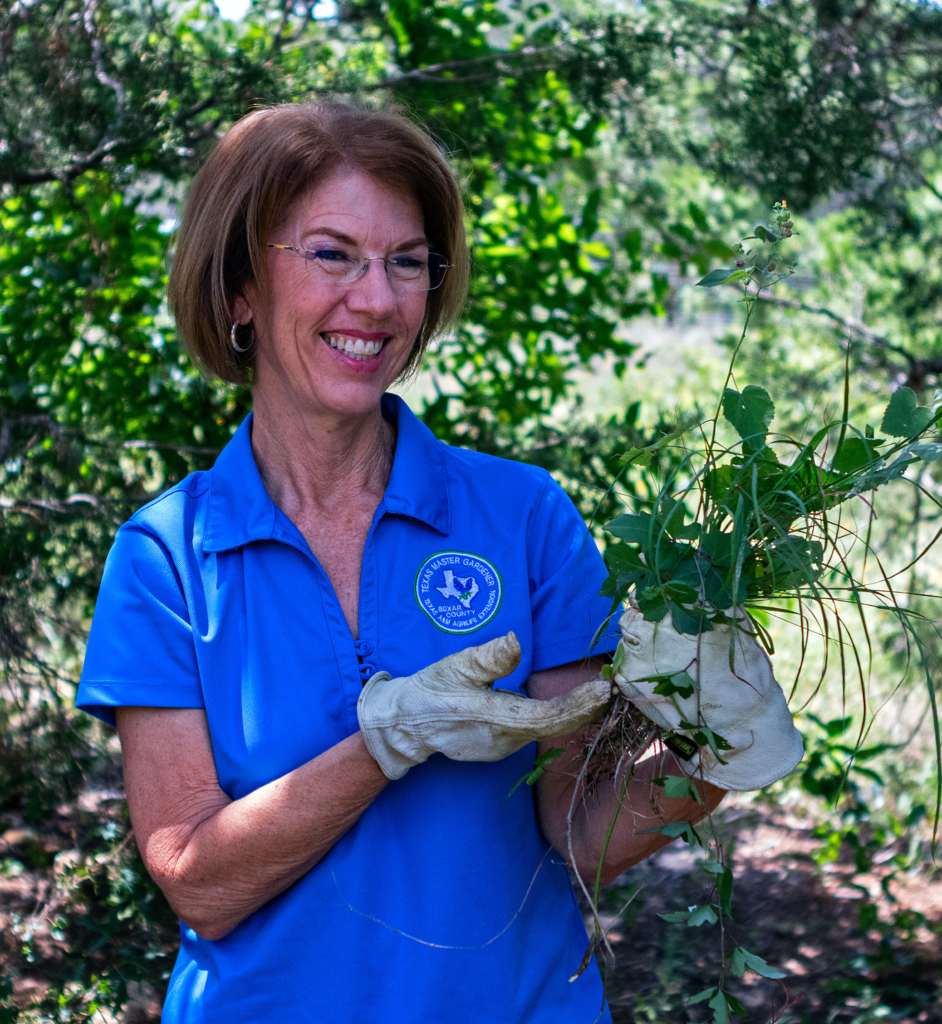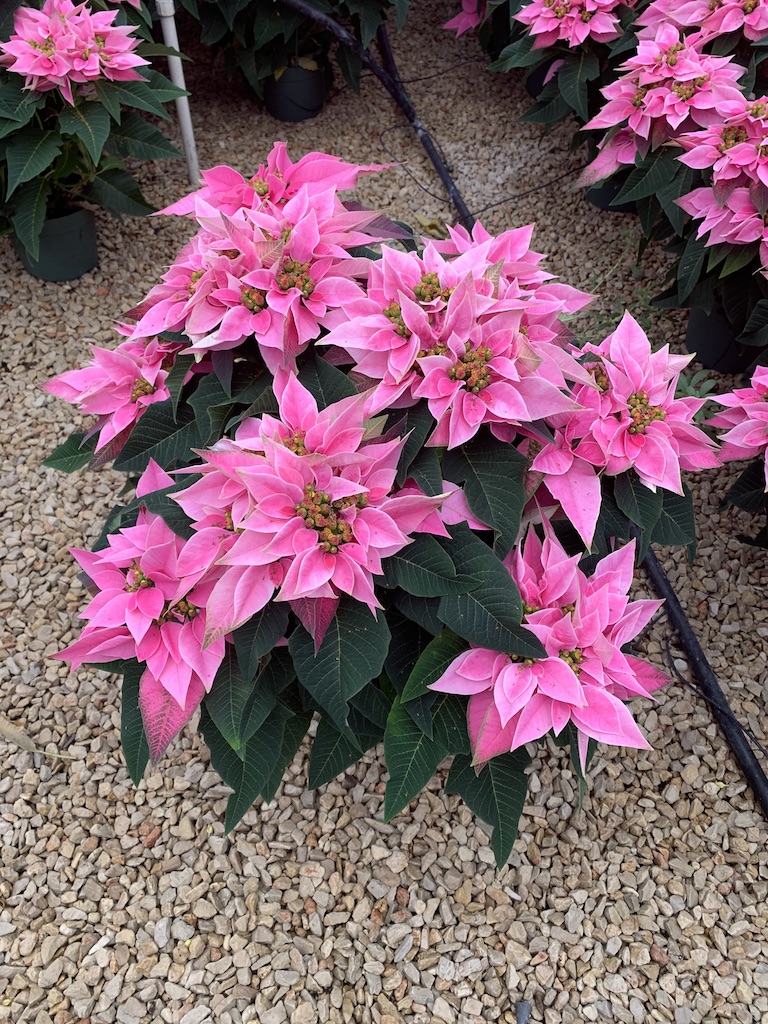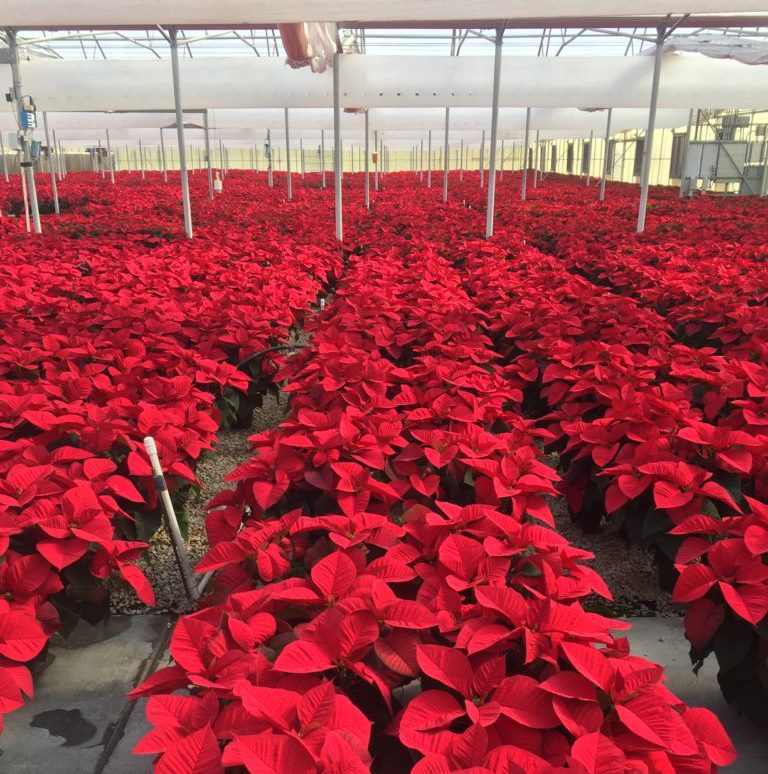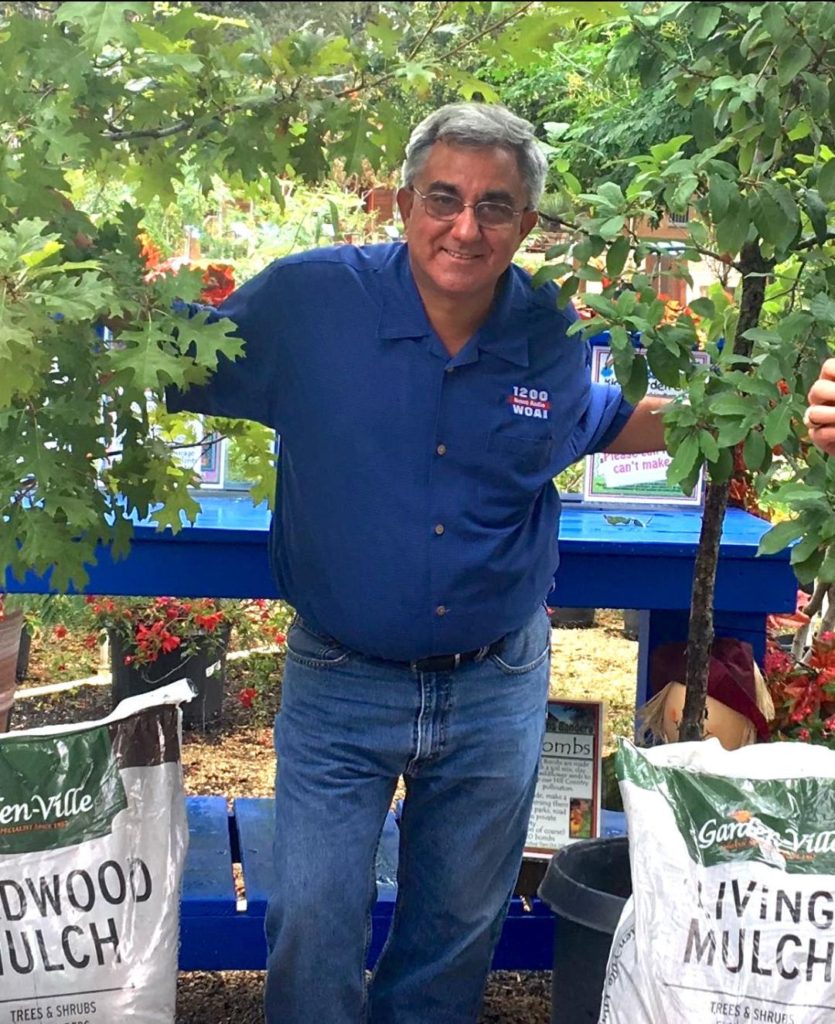
Volume 30, Issue #11 – November 2020

BCMG President

November is a transitional month in the garden. The deciduous trees are going bare and the warm season harvests are finishing up. We are changing out summer annuals for pansies, dianthus, alyssum and snapdragons. Bulbs and wildflower seeds are planted with an eye for next spring. Our gardening chores are slowing down, giving us more time. Time to enjoy the birds feasting on the berries and seed heads in our garden. Time to plan for the coming holidays. Time to prepare ways to share those holidays safely with our family and friends. And time to give thanks for all the good things we have in our life.
Happy Thanksgiving to all of you!
Lynn
Scion Index – Click and Go!
- This Month’s Presentation– Rain Gardens for Wildlife and Water Quality
- Water Wise Words
- Poinsettia Sale
- Texas Superstar Spotlight – Lynn’s Legacy Cenizo
- In the Garden Articles
- Trichocereus Hybrid
- What’s Wrong With My……?
- Poinsettia 101
- Gardening Education – Online Opportunities
- Master Gardener Corner
BCMG offices are open at 25%. You must have an appointment to go in. Call before going over.
Offices will be closed November 11 for Veteran’s Day
Offices will be closed November 26 and 27 for Thanksgiving Holiday
All monthly meetings and presentations for the rest of 2020 will be on-line webinars held on Zoom.
The first time you use Zoom, allow a few minutes extra to get set up. Zoom can be used free on home PCs, Macs and on smartphones.
Pre-Registration on Zoom is required for each webinar. (Equivalent to the “Sign-in sheet”). Register weeks ahead of time or even just a few minutes before the webinar and the link will be sent to you in email.


Hello Fellow Gardeners!
I hope you are all enjoying these cooler temperatures and the roller coaster ride that has been our weather recently. At least Texas can’t be accused of having boring and predictable weather.
As we begin to prepare for the change in seasons in our landscapes, I would like to remind everyone to remember the importance of conserving that precious natural resource, our water. San Antonians have done an exceptional job over the years conserving water both inside the house and out in the landscape. Let’s keep that going as we move out of this most unusual year and into 2021.
We can start by turning off our automatic irrigation systems until the early spring and consider converting part of that system to a drip system instead of spray. Drip irrigation is a more efficient method of applying water because the water is applied at or below the soil surface, and evaporation is significantly reduced.
The second thing we can do in our landscapes to help conserve water is to add another layer of compost to garden beds and turfgrass. Organic matter increases the moisture holding capacity of our soil and provides nutrients and numerous benefits to our soil and plants. Simply move the mulch from the garden beds out of the way and add the compost. Then push the mulch back on top of the soil. On your lawn, just add the 1” layer of compost and gently work it in to the turf with a garden rake. In a few days, that compost will have disappeared to work its magic along with the soil microorganisms.
And finally, we can add another layer of mulch on top of our garden beds. Just put the new layer right on top of the old mulch. This acts as a blanket for the plant roots and will help to keep the soil warmer during the winter months and holding in some of the moisture as well.
For more information on all of these suggestions, please visit our digital gardening library at: https://bexarmg.org/may-we-help/gardening-information-library/irrigation-water-conservation-practices/
Thank you and happy fall y’all!
Conservationally Yours,
Anna Vogler, BCMG Water Conservation Coordinator
Poinsettia-sale4


Trichocereus-Hybrids4
Abiotic-Problems4

Poinsettia 101
Jodi Perez,
Bexar County Master Gardener
Poinsettias are easily associated with the holiday season. We buy 35 million each year. We buy real ones. We buy artificial ones. But what do we really know about them? Where are they from? Are those really flowers on top of the plant? We have answers to those questions and more so buckle up, it’s kind of a wild ride.
Poinsettias are native to Mexico, where they were cultivated by the Aztecs and prized by kings. The first religious connotations were placed on them in the seventeenth century. Due to their beautiful blooms and holiday blooming time, Franciscan Priests used them in nativity processions.
Poinsettias were introduced to the United States in 1825 by Joel Robert Poinsett. He was an accomplished botanist and U.S. Ambassador. While in Mexico, he came across the plants growing on hillsides and had some plants sent to his home in South Carolina. From there, poinsettias were supplied to greenhouses across the country and the world.

Poinsettias are not only beautiful but also unique. The colored part of a poinsettia that we most often think of as the flower is not a flower. It is called a bract. A bract is a modified leaf. the flowers of a poinsettia are quite tiny, and you can see them if you look carefully toward the top of the plant. Because of their unique beauty, there are now more than 100 different varieties of poinsettia that come in traditional colors such as red and other colors such as pink, burgundy, marbled, and speckled.
The Poinsettia is also the victim of a myth that its leaves are toxic. The safety of poinsettias in the home is demonstrated in scientific studies conducted by Ohio State University in cooperation with the Society of American Florists. The study concluded that no toxicity was evident at experimental ingestion levels far exceeding those likely to occur in a home environment. In fact, the POISINDEX Information Service, the primary information resource used by most poison control centers, states that a 50-pound child would have to ingest over 500 poinsettia bracts to surpass experimental doses. Yet even at this high level, no toxicity was demonstrated. As with all ornamental plants, the poinsettia is not intended for human or animal consumption.

Poinsettias are unique, beautiful, and festive. I’m sure many readers are going to buy one from a fundraiser, nursery or the many retailers that will supply them this holiday season. You also may have heard that poinsettias are difficult to take care of. Don’t be discouraged! Here are some pointers that will have your plant lasting through the holiday season and beyond:
- Location and Temperature: The poinsettia thrives on indirect, natural daylight, and exposure to at least six hours daily is recommended. If direct sun cannot be avoided, diffuse with a light shade or sheer curtain. To prolong the bright color of the poinsettia bracts, daytime temperatures should not exceed 70° F. Avoid placing the plants near drafts, excess heat, or the dry air from appliances, fireplaces, or ventilating ducts.
- Water and Fertilizer: Poinsettias require moderately moist soil. Water the plants thoroughly when the soil surface feels dry to the touch. Remove the plant from decorative pots or covers, and water enough to completely saturate the soil. Do not allow the poinsettia to sit in any standing water; root rot could result which could kill the plant. It is not necessary to fertilize the poinsettia when it is in bloom.
- Outside Placement: Since poinsettias are sensitive to cold weather, frost, and rain, outside placement during the winter months should be avoided. However, in mild climates, an enclosed patio or entry way may be suitable, provided the night temperatures do not drop below 55 degrees F. Make certain the delicate bracts are well protected from wind and cold rain.
Poinsettias are a lovely addition to any winter holiday display. If you follow the tips above, your poinsettia will continue a beautiful show of color through and maybe even beyond the holiday season. If you wish to try your hand at keeping your poinsettia alive to bloom in future years, you can get detailed care instructions here.
Happy Holidays!
Gardening Education Opportunities

Nov 11 – Pantry Pests
It’s baking season! And this is also the time of year we find some bugs in our pantry. Learn how to manage them and where to look to find them so you don’t have to throw out good food.
Nov 18 – Gnats in the House
As the weather cools, the indoors gets warmer, and we bring the plants in out of cold, gnats will thrive. It can be an easy fix, if you know what to do!
Join these webinars Meeting ID: 990 2593 9574, Passcode: Garden2020

Cold temperatures are coming
Plant fruit trees the AgriLife Extension way
How to choose the right fertilizer for home vegetable gardens
Top tips for a successful fall vegetable garden
Frequently check the BCMG Calendar, as that is where all the new, upcoming programs will be posted. Click Here

Past webinars are posted on YouTube for your viewing (or reviewing) pleasure! Check often for new postings! Click here for the list.
- Dragonflies of Texas
- Arachnids of Texas
- Where Do Insects Go When It Rains? by Molly Keck
- 12 Months of Vegetable Gardening by David Rodriguez
- Pests of Tomatoes by Molly Keck
- Growing a Fall and Winter Vegetable Garden
- 12 Months of Pollen and Nectar Producing Plants for Pollinators
- Turf Grass Basics: Surviving Summer and the Rest of the Year
- Vegetable Garden Basics
- Top 10 Insects of Summer
- Tropical Escape with Texas Superstar Plants

https://aggie-horticulture.tamu.edu/fblive/https://aggie-horticulture.tamu.edu/fblive/
Just a few of them are:
- Compost versus Mulch
- Planting Strawberries
- Fall Blooming Flowers & Biennials Planted in Fall
- Harvesting Pecans
- Raised Garden Beds, Location, Soil Mixtures and more!
- Home Fruit Production – Tips for Success!
- Small fruits for the backyard
- Floral Designs from your backyard – Growing, Cutting, Using your flowers and shrubs!
- How to Prune Your Trees
- Indoor Gardening

Get the full list here
- Landscape Water Conservation
- Low-Volume Irrigation
- Irrigation System Auditing
- Safe Use and Handling of Pesticides
- Safe Use and Handling of Fertilizers
- Composting
- Designing an Earth–Kind® Landscape
- Landscaping for Energy Conservation
- Creating Native Habitat
- Earth–Kind® Roses
- Integrated Pest Management

BCMG is on YouTube! Watch classes on a computer (or on your smartphone)!
- Native Plants for Native Birds
- Crape-Myrtle Bark Scale
- Herb Gardening
- Propagation by Cuttings
- Rainwater Harvesting with Lou Kellogg
- Texas Superstars
- Starting Vegetables from Seed Indoors
- Organic Gardening
Check often for other new videos! The whole list of available videos is HERE.


Call in to Live Radio on Saturday mornings, with your gardening questions for David.
Call in: 210-737-1200 or 1-800-383-9624 on Saturdays from 7 am to 10pm
Or just listen to the show, and learn from everyone else’s questions!
WOAI 1200 AM – Lawn and Garden Show
Host: David Rodriguez, Bexar County AgriLife Extension Horticulturist.
Past shows are archived here, for easy listening on your computer, tablet or phone, anytime! Listen on your phone while you drive!

Ask a Master Gardener
Master Gardeners are available to help you with your gardening questions. We provide unbiased, research-based, locally relevant gardening information. Free service. You can reach us:
By phone: 210-631-0400 (Ask to speak to a Master Gardener)
Mon-Fri 9 am – Noon, 1-4 pm (Closed on county holidays)
Even during Covid-19 precautions, the phones and the Hotline are being operated from home telephones, hotline calls are being directed by AgriLife Extension receptionist Nick Vasquez.


Member’s Corner

Each year, Master Gardeners must certify for the following year. Once they complete requirements, they receive the Maroon Bluebonnet Service Pin. They must complete:
- at least 30 volunteer hours in the community
- 6 Continuing Education Units (CEUs) to keep their knowledge current
- attend two regular BCMG monthly meetings.
Congratulations to the Bexar County Master Gardeners who earned their 2020 certification in October.
Nancy Alford
Kathy Breniman
Linda Cace
Shirley Conrad
Nora Fellows
Sandra Patricia Hernandez-Lascurain
Michelle Hobbs
Judie Lopez
Mary Mangiapane
Linda Milikien
Pat Simpson
Art Snow
Diane Surdi
Barbara Wardwell
